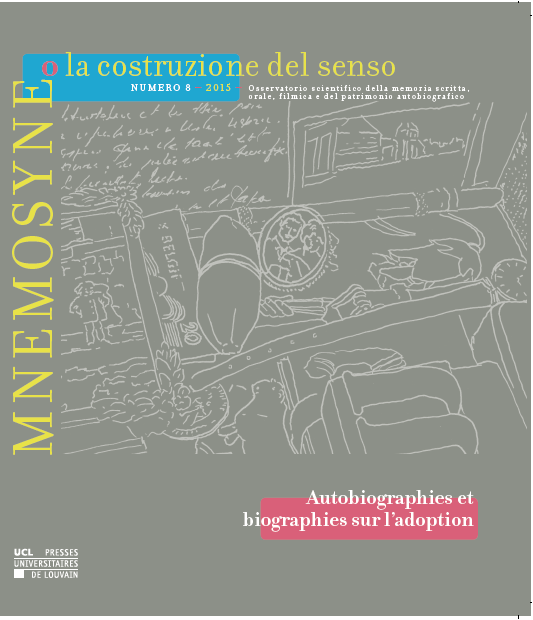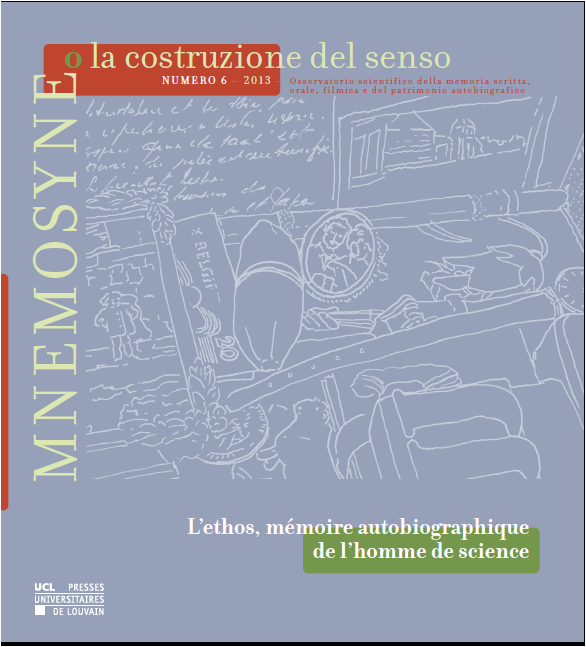Publications
Salon de la revue Paris 13-15 Octobre
Mnemosyne o la costruzione in Open access
University of Cyprus ‒ Mediapolis Europa
International meeting of the Scientific Observatory of Autobiographical Memory
in Written, Oral and Iconographic Form
‒ Nicosia, 1-2 November 2019 ‒
Argument Volume
Auto/biography :
premonitions, dreams, nightmares
ἐπάμεροι: τί δέ τις; τί δ᾽ οὔ τις; σκιᾶς ὄναρ ἄνθρωπος
(Creatures of a day. What is a someone, what is a no one? Man is the dream of a shade.)
Pindar, Pyithian 8
We are such stuff as dream are made on,
and our little life is rounded with a sleep.
William Shakespeare, The Tempest
Le dormeur assemble des images comme le poète assemble des mots :
il en use avec plus ou moins de bonheur pour parler de soi à soi-même
The sleeper assembles images the way the poet assembles words :
he makes use of them more or less felicitously to speak about himself to himself.
Marguerite Yourcenar, Dreams and Destinies
Introduction
Everything that occurs in the realm of sleep and dream has always aroused the interest of mankind. Since antiquity, the dream is a mysterious component of life around which many questions are still asked. In many films and contemporary texts, there emerges the ancient idea of dream as anticipation, premonition, or sharing of collective sentiments. And the sciences investigate in order to offer a rational explanation of what happens in the mind.
The International meeting that will be held in Nicosia (Cyprus) on 1 and 2 November 2019 aims to deal with the way in which dreams structure autobiographical narrations. We will therefore restrict ourselves to suggesting cues for reflections on different approaches to dream over time, and through the lens of different disciplines, with the understanding that the focus of this symposium is to observe and understand what forms dreaming takes in autobiographical writing.
The ego in the singular has been a true discovery in the West, famously with Freud, so much so that the collective psychology that hides behind dreams has been overlooked. With all its therapeutic baggage in the singular, psychoanalysis affected the very way of conceiving of the dream, when in the history of culture the dream also inscribed itself into the history of ideas and of the ethical and religious convictions of a society.
Following a temporal linearity, and in a nutshell, we can recall that in Greco-Roman antiquity two opposite conceptions manifest themselves : one postulates the existence of an underground dialogue with demons (see for example the dream that announces his death to Socrates in Plato’s Crito), embodying amor fati [love of one’s fate]; the other puts parrhesia ‒ speaking in public openly ‒ in the foreground, as Foucault artfully explains and documents in his study of the hermeneutics of the subject in the Greco-Roman era (The Courage of Truth. The Government of Self and Others, 1984). Parrhesia presents itself as the choice of a human being who intends to ethically rise to total transparency and to the truth of what one says, rejecting whatever is obscure, nocturnal, unsaid, inexplicable. Veritable techniques were developed to steer thought, the mind in its most hidden recesses.
In a Letter to Lucilius (n. 53), Seneca emphasises that in order to be able to narrate, we must be awake and that, when it is very deep, sleep even extinguishes dreams. Only a rational philosophical awareness will be able to break our lethargy.
Centuries afterwards, Pascal in his Pensées, published posthumously in 1670, alerts us to pay close attention to the fragile border between wakefulness and dream.
Collective dreams
The narration of dreams can be woven by stories that are permanent and underlying their own culture, shared and reiterated.
For example, the medieval iconography of dreams finds its primary source in the Old Testament. The representations of dream in Jacob’s Ladder or the dreams of his son Joseph come from Genesis, the two dreams of Nebuchadnezzar from the Book of Daniel.
In an afterword entitled « Du ‘moi’ du rêve au ‘je’ du récit et de l’image », Jean-Claude Schmitt shows how dream in the Middle Ages « poses the very question of literature » (p. 234). Schmitt explains that this literature starts from a ‘me’ spectator to arrive at a narrating ‘I’ ‒ a shift that is accomplished at the very moment of the birth of romance literatures, which could not have occurred, if not in a dimension of reverie.
In the 20th century, the ancient dialogue with demons becomes interiorised, personalised, and biblical or wondrous dreams are sometimes replaced by a monologue between ‘me’ and ‘self’ like in Marguerite Yourcenar’s (pseudo-) Memoirs of Hadrian, where a whole vocabulary modulates reality, expectations, dreams. The book ends with the emperor’s poem on his afterlife, Animula vagula, blandula… The word ‘vague’ is present in Greek texts and is taken up by Leopardi, for example, and other authors, this word meaning the fragile border between sleep, dream, the infinite, the indefinite.
In our time, the collective dimension of dream has got lost or does not attract – besides Jung and his archetypes – proper attention. And yet, little by little, in some written or cinematographic works we can see growing interest in the symbolic and evocative or premonitory recurrences of emerging dreams in a community. And art, which has always had a visionary side, proves to be a fertile ground for suggestions : from Surrealism, through Paul Klee (Angelus novus ,1919), to many more expressions.
Federico Fellini was a master in articulating factual experience and dreams (see Amarcord, 1971).
From Psychoanalysis to Neurosciences
We must emphasise that if psychoanalysis has shown its interest primarily in the individualistic side of dreams, in parallel it has inaugurated the study of the relationship between myth and dreams.
Today, in the field of psychiatry, neurosciences and pure sciences, the autobiographical narrations of dreams have progressively become essential tools for understanding some pathologies, some processes of discoveries, some functions of the brain with unpredictable ways of functioning. Added to this symptomatic dimension of dream is a creative function: some scientists reveal that some discoveries were born from their dreams. Equipped with new knowledge, neurosciences take an interest in the realm of premonitions in order to once again pose the ancient question : can there be clues to as to whether our ‘inner forum’ unconsciously unites and makes us significant? Are dreams the memory of our ancestors? Or, in contrast, are they none other than free and creative associations that have nothing in common with our life when we are awake? And above all, how can we understand them through narration in the traditional oral, written or iconographic form?
Bibliography
Charlotte BERADT, Rêver sous le IIIe Reich, (1933 à 1939), tr. P. Saint-Germain, Paris, Payot, 2002. [1966].
Daniel BERGEZ, Peindre les rêves. Des rêves bibliques au surréalisme, Paris, Hachette, 2017.
Gisèle BESSON, Jean-Claude SCHMITT, trans. by the Latin G. Besson, Rêver de soi. Les songes autobiographiques au Moyen Âge, Toulouse, Anacharsis, 2017.
Pedro CALDERÓN DE LA BARCA, La vida es sueño, Madrid, 1636.
Jacqueline CARROY (éd.), Rêver au XIXe siècle, Paris, Hachette, 2018.
Robert DESOILLE, Liberté et direction dans le rêve éveillé Genève, Action et Pensée, 1956, XXXII, N°1.
‒ Le rêve éveillé comme méthode d'exploration et de cure psychologique. Archives hospitalières, Paris, 1957, N°8.
Eric DODDS, The Greeks and the irrational, University of California Press, 1951.
Nicole FABRE, Au miroir des rêves, Paris, Desclée de Brouwer, 2001.
Michel FOUCAULT, Le courage de la vérité. Le gouvernement de soi et des autres, I-II, Paris, Gallimard-Seuil, 2009.[1984]
Sigmund FREUD, The interpretation of dreams, ed. James Strachey, New York, Basic Books, 2010. (Die Traumdeutung), 1899.
Laurent JENNY, « Voir en rêve », Poésie, 2017/1 (No 159), p. 122-133.
Carl Gustav JUNG, Aniela JAFFÉ, Memories, Dreams, Reflections, New York, Random House, 1965, [Erinnerungen, Träume, Gedanken, 1962].
- L'analisi dei sogni (1909), trans. by Lucia Personeni and Silvano Daniele, Torino, Boringhieri, 19782015.[1899]
Jacques LE GOFF, « Le Christianisme et les rêves (IIe-VIIe siècle) », in L’imaginaire médiéval, Paris, Gallimard, 1985.
− « Les rêves dans la culture et la psychologie collective de l’Occident médiéval », 1977, (299-306); « Rêves », in Le Goff et Schmitt (ed.), 1999 : 950-968] ; [1990].
Jean-Claude SCHMITT, Les revenants. Les vivants et les morts dans la société médiévale, Paris, Gallimard, 1994.
− Le corps, les rites, les rêves, le temps. Essai d’anthropologie médiévale, Paris, Gallimard, 2001.
− « Récits et images de rêves au Moyen Âge », Ethnologie française, 2003/4
https://www.cairn.info/revue-ethnologie-francaise-2003-4-page-553.ht
Élisabeth ROUDINESCO and Michel PLON, Dictionnaire de la psychanalyse, « Interprétation du rêve (L’) », Paris, Fayard, 2011.
SENECAE, Epistulae Morales ad Lucilium (A.D. 62-65).
Jean STAROBINSKI, «L’Empire de l’imaginaire», pp. 205-292, in Id. L’œil vivant, Paris, Gallimard, 1999.
Marguerite YOURCENAR, Les Songes et les Sorts, Paris, Éditions Grasset, 1938.
Edwina PORTOCARRERO, David CRANOR, V. Michael BOVE, «Pillow-Talk : Seamless Interface for Dream Priming Recalling and Playback», MIT Media Lab, 22 June 2011.
Filmography
Sophie BRUNEAU, Rêver sous le capitalisme, 2017.
Federico FELLINI, Amarcord, 1971.
David LINCH, Mulholland Drive, 2002.
Alain RESNAIS, L'Année dernière à Marienbad, 1961.
Andreï TARKOVSKI, The Mirror, 1975.
Florian Henckel VON DONNERSMARCK, Werk ohne Autor, 2018.
Web sites
http://web.media.mit.edu/~vmb/papers/4p375-portocarrero.pdf
https://www.epochtimes.it/news/5-scoperte-scientifiche-create-grazie-ai-sogni/
https://www.cairn.info/revue-cahiers-jungiens-de-psychanalyse-2002-1-page-109.htm
Lines of research
The contributions can follow one or more of the following guidelines, or other guidelines of choice.
Guideline I
Representation of the dream function
The individual and basic structure of dream
Guideline II
The writing of dream: its techniques, its obstacles, its challenges
The ethical dimension of dream: the reality of dream, the image of the real
Guideline III
Describing oneself through dream
The dream as a manifestation of one’s own destiny
Confirmed speakers
Beatrice Barbalato (University of Louvain-la-Neuve, Mediapolis.europa)
May Chehab (University of Cyprus)
Yiannis Ioannou (University of Cyprus)
Scientific committee
Beatrice Barbalato (University of Louvain-la-Neuve, Mediapolis.europa)
May Chehab (University of Cyprus)
Francoise Hiraux (Louvain Archives)
Yiannis Ioannou (University of Cyprus)
Organizing committee
Irene Meliciani, Managing director of Mediapolis.Europa, This email address is being protected from spambots. You need JavaScript enabled to view it.
Fabio Cismondi, This email address is being protected from spambots. You need JavaScript enabled to view it.
Maria Papandréou
Christina Stylianidou
Location
University of Cyprus
Nicosia, CYPRUS
URL of reference
Accepted languages
French, English, Spanish, Italian.
In order to understand the contributions to the symposium, a minimum level of understanding of the above-mentioned languages is expected since simultaneous translation is not provided.
Partners
PAST EVENTS
- Mediapolis.Europa is happy to announce that mnemosyne o la costruzione del senso is now part of ERIH
- Mediapolis.Europa in radio fahrenheit
- Prof Beatrice Barbalato à France Culture La conversation scientifique
PAST EVENTS
- Mediapolis.Europa is happy to announce that mnemosyne o la costruzione del senso is now part of ERIH
- Mediapolis.Europa in radio fahrenheit
- Prof Beatrice Barbalato à France Culture La conversation scientifique








